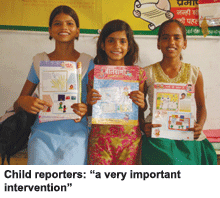India’s most populous (180 million) Hindi heartland state of Uttar Pradesh (per capita income: Rs.13,262; adult literacy: 56.3 percent), (mis)governed with an iron hand by woman chief minister Mayawati and her acolytes of the Bahujan Samaj Party, is notorious for neglecting education and children’s rights. Yet it’s a refreshing paradox that a group of children in two of the six blocks of Lalitpur — one of UP’s most backward districts where the under-five mortality rate is 159, only 55 percent households have access to clean drinking water, a mere 23.3 percent children receive full immunisation and barely 17.2 percent of the households have access to toilets — is writing on socio-economic issues as they see them.
 These are Lalitpur’s child reporters (CRs) who have been active since 2006, participants in a United Nations Children’s Fund (Unicef)-supported programme which encourages children to become fact finders on the premise that they are more knowledgeable about local issues, and as first generation literates are respected by their families and other rural households. And also, because they tend to tell it like it is.
These are Lalitpur’s child reporters (CRs) who have been active since 2006, participants in a United Nations Children’s Fund (Unicef)-supported programme which encourages children to become fact finders on the premise that they are more knowledgeable about local issues, and as first generation literates are respected by their families and other rural households. And also, because they tend to tell it like it is.
For instance, in village Jamalpur, Uma Devi Bhargava, a class VI student doesn’t hesitate to refute the village headwoman’s contention that she makes surprise checks of the primary school’s mid-day meal programme to guarantee quality. “We are forced to eat under-cooked rice, or there are no rations. For the past month there has been a food shortage in our school. And the job of preparing the mid-day meal has been given to an untrained person,” she says forthrightly.
Newsreports, essays, poems and drawings of 56 children (32 girls, 24 boys) aged eight-14 of the Talbahet and Birdha blocks are collated into a news booklet Balvani (‘Voice of children’) every quarter. Though the process of selection of CRs reduces their number as school teachers are asked to select bright and articulate children, their output has begun to make an impact. When 12-year-old Anup Singh’s sketch of a sleeping teacher in a class full of children (born out of his experience at his primary school in village Sunaora), published in the inaugural issue of Balvani (May-July 2006) reached the district officials, the teacher was suspended.
In village Jamalpur, Madhu Raja, a class VII student is writing a report outing school principals demanding bribes for enrolment. For Sonam Vishwakarma, each day is a new learning experience. “Only yesterday I learnt that education till class XII is completely free for girl children. Through Balvani I want to pass this message to all children,” she says. Moreover, Sonam advised two children from a Sahariya (tribal) hamlet to confront their village headman to insist that the well in their village be cleaned. “The well was cleaned within three days and the children — and their parents — are very happy,” she says.
The efforts and output of the CRs of Lalitpur have drawn praise from media veterans. In November last year, at the first National Convention of Child Reporters held in New Delhi, attended by 70 CRs from 14 states, pressmen invited to meet with them, were stumped. Senior Hindi journalist Ram Sharan Joshi complimented them for being “real reporters, authentic, genuine and grassroots”. “Journalists in the cities have climbed the branches and forgot-ten the roots. Your reportage brings the nation back to its roots, to the reality of so-called shining India,” he said.
According to Augustine Veliath, Unicef UP’s communication specialist based in Lucknow, the original purpose of publishing Balvani was to promote behavioural changes in five thematic areas — health and nutrition, pre-school and elementary education, washing of hands, environment management and sanitation. “The CR initiative has moved far beyond its original purpose and evolved into a very important intervention. Articulate and aware children are the best advocates of children’s issues and rights,” he says.
Vidya Pandit (Lucknow)